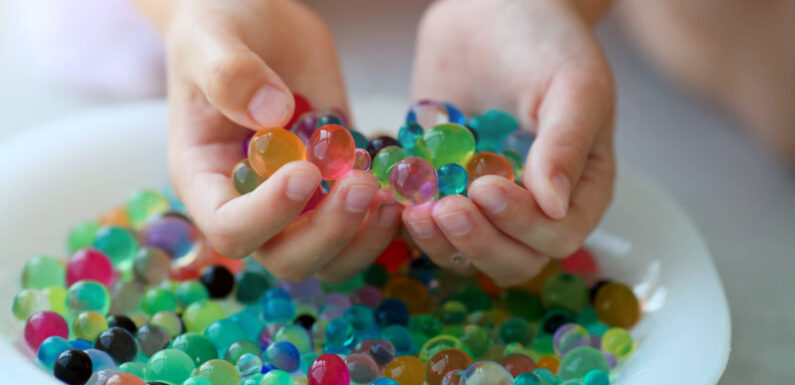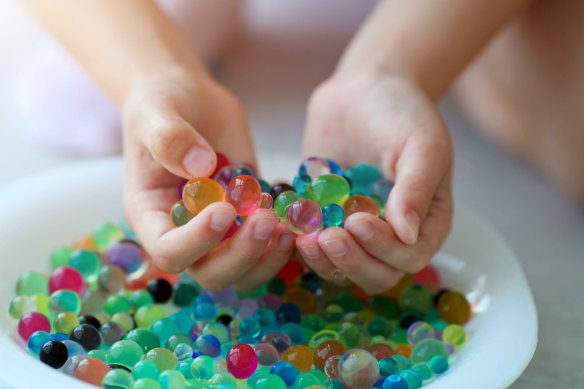
Save articles for later
Add articles to your saved list and come back to them any time.
When shopping for toys, we often want to pick something fun. But can some of them also be dangerous?
According to emergency room doctors, they can be. In a video that went viral on TikTok, Meghan Martin, a pediatric emergency medicine physician at Johns Hopkins All Children’s Hospital in the US, said certain gifts can land children in emergency.
Water beads may be popular sensory toys, but they pose a risk to young children.Credit: iStock
“It’s important to know the risks,” Martin says in a phone interview, adding that it’s up to parents to make decisions based off that information.
So which toys pose the highest risks? We asked doctors across the country that question and how adults can help keep children safe.
Water beads
These brightly coloured beads grow exponentially when immersed in water, making them popular sensory toys. But emergency doctors and safety experts caution against them.
Young children may put the beads in their ears, nostrils or, worse, their mouths. When swallowed, the beads can continue to absorb water and grow in the intestinal tract, leading to blockages and life-threatening injuries, says Sarah Combs, an emergency medicine physician and director of outreach for the emergency department at Children’s National Hospital in Washington, DC.
In her emergency room, Combs says she has not personally seen these beads caught in the gut, but has seen them in the ears and nose. Such objects are usually pulled out with a specialised tool, but sometimes, because the beads are “slippery and expanded, we can’t,” Combs says. In those cases, children may require surgery to remove the beads, she says.
Toys with magnets and button batteries
Toys with magnets or button or coin batteries are choking hazards, but many parents don’t know they can cause severe internal damage or even death.
“If you swallow a battery or magnet, you can get decreased blood supply to areas of the bowel or tissue necrosis – the death of body tissue,” says Kerri Layman, the chief of emergency medicine at MedStar Georgetown University Hospital in Washington, DC.
Swallowing button batteries can also lead to burns, she says.
This happens when a button battery comes into contact with saliva or other bodily fluids. The current in the battery causes a reaction that can burn a hole in the tissue.
The most serious issues typically occur in the esophagus, Layman says, because the batteries can get stuck at the narrow area behind the thoracic inlet, which is between the neck and the chest. Be mindful that children can get access to the batteries even when they are enclosed.
“Sometimes the screws holding button batteries in place may be loose and fall out,” Layman says. But generally, “those that are screwed in properly are much more safe than those that are just accessed via a tab closure”.
Electric scooters and hoverboards
Don’t buy electric vehicles such as scooters and hoverboards for children, emergency room doctors and safety experts say. They can go fast, “and you don’t really want a child careening at those speeds,” Combs says.
That can lead to broken bones. These fractures can usually be reset in the emergency room but may require surgery in more serious cases, Combs says.
Non-motorised scooters are considered a safer choice, though they are a leading cause of injuries. But because non-motorised scooters travel at slower speeds, the injuries that come from them are usually less severe, Combs says.
When giving children non-motorised bikes and regular scooters, provide safety gear to go with it, Combs says.
Trampolines
Although kids love them, trampolines are a common cause of a wide range of injuries.
The most common ones that Joanna S Cohen, a pediatric emergency medicine physician at Johns Hopkins Hospital in Baltimore, has seen are sprained ankles and broken arms. This usually occurs, she says, when more than one child is jumping and they collide with each other.
Injuries can also occur from falling on the springs or the frame of the trampoline, falling off the trampoline or attempting flips or other “risky” stunts and landing incorrectly, Cohen adds.
Martin says young children have also come into the hospital with lower leg injuries, usually a fracture in the tibia, from bouncing on trampolines. This can happen when a child is jumping on the trampoline by themselves, but it’s more common when there are two people of different sizes.
“The person that is larger is creating more force, and that force is being exerted on the smaller person,” Martin says.
Getting an in-ground trampoline or having a net around it may reduce the risk of falling off, but it provides only a false sense of security, Martin says.
Rocket launchers and other projectiles
Toys that shoot projectiles, such as rocket launchers, toy guns or slingshots, can cause various injuries, including to the eyes. The toy may inadvertently go off during play, launching a projectile and hurting the child’s eye, causing a severe close-range injury, Combs says.
“Please don’t buy projectiles that shoot small pieces at children,” Cohen says.
Washington Post
Make the most of your health, relationships, fitness and nutrition with our Live Well newsletter. Get it in your inbox every Monday.
Most Viewed in Lifestyle
From our partners
Source: Read Full Article
